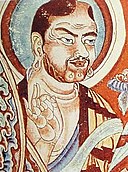Датотека:Central Asian Buddhist Monks.jpeg
Central_Asian_Buddhist_Monks.jpeg (470 × 591 пиксела, величина датотеке: 173 kB, MIME тип: image/jpeg)
Историја датотеке
Кликните на датум/време да бисте видели тадашњу верзију датотеке.
| Датум/време | Минијатура | Димензије | Корисник | Коментар | |
|---|---|---|---|---|---|
| тренутна | 14:25, 27. март 2005. |  | 470 × 591 (173 kB) | Beta m common | 9th century fresco from Bezeklilk, Tarim Basin. {{PD-art}} |
Употреба датотеке
Глобална употреба датотеке
Други викији који користе ову датотеку:
- Употреба на ar.wikipedia.org
- Употреба на ast.wikipedia.org
- Употреба на az.wikipedia.org
- Употреба на ba.wikipedia.org
- Употреба на bg.wikipedia.org
- Употреба на bjn.wikipedia.org
- Употреба на bn.wikipedia.org
- Употреба на bs.wikipedia.org
- Употреба на bxr.wikipedia.org
- Употреба на ca.wikipedia.org
- Употреба на cs.wikipedia.org
- Употреба на cv.wikipedia.org
- Употреба на da.wikipedia.org
- Употреба на de.wikipedia.org
- Употреба на de.wikivoyage.org
- Употреба на el.wikipedia.org
- Употреба на en.wikipedia.org
Још глобалног коришћења ове датотеке.

